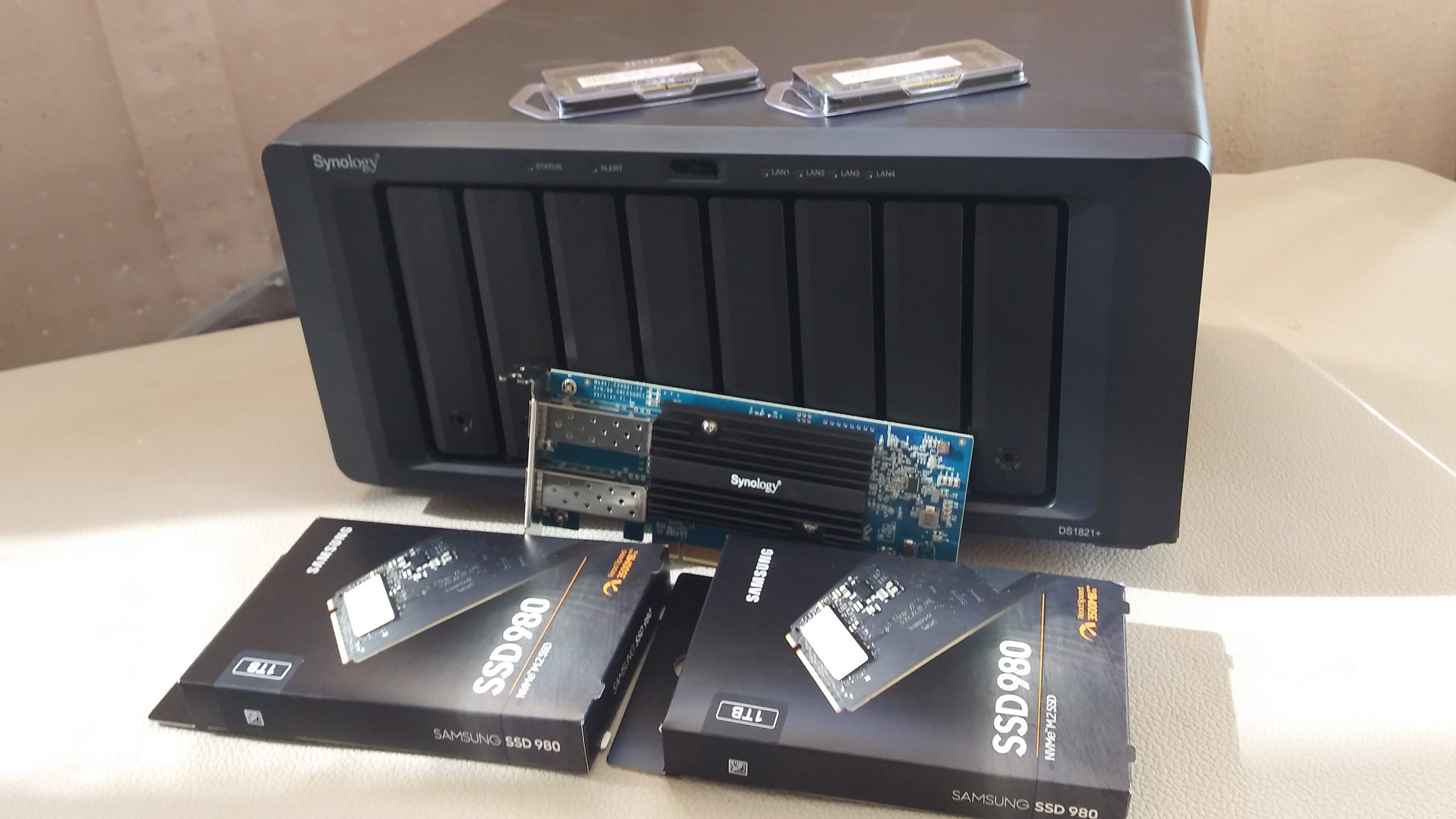Synology DS1821+ Review
Anyone who uses multi-terabyte disk storage can benefit from using Network-Attached Storage (NAS) to manage that disk space. My use cases are photography, video, and home PC backups. My requirements are that a storage solution is fast, reliable, expandable, easy to manage, and future-proof. Note that I did not say ‘cheap’, although when you consider alternative methods of storing your data, a case could be made that NAS solutions are affordable.
My previous NAS was a Synology DS1019+ five bay unit, which served my home LAN for several years. The feature I liked the best about it was its hardware video transcoder, which could simultaneously transcode as many as 8 video streams without trouble; and thus it was my ultimate Plex server. The problem with it was that it only had two 1gig ethernet ports, and even though I had them bonded, it had no options to expand when I moved up to 10gig speeds on my home network. (There is nothing wrong with this NAS… it can easily handle 3 active PCs daily.)
I eventually upgraded to the unit I am reviewing today. It has 8 hot-swappable drive bays, 4 1gig ethernet ports, and importantly to me, a PCIe slot to which I added a 2-port SFP+ 10gig ethernet card. Also added were dual 1TB NVME sticks for cache, and 32Gigs of RAM.
Future-proof: The process of upgrading from the DS1019+ to the 1821 was rather easy… I removed my 8TB drives from my old unit, and inserted them into the new unit, being careful to match each drive to its proper drive bay. I powered up the 1821, and it could not see the old volumes. Oh… I had not stopped the cache on my old unit, so I installed the old sticks, the 1821 saw the data, recognized that it was from another NAS, prepped the volume for the new hardware, downloaded the latest DSM (7.1) operating system, rebooted, and my new NAS was ready to go. (I also had to disconnect one ethernet connection and reconfigure that interface to a single cable.) I disabled the cache, removed the sticks, installed the new bigger sticks, restarted, created a new cache, and I had a working NAS. That upgrade path could not be easier.
Expandable: Once my budget had recovered from the initial purchase, I bought 5 Seagate 14TB NAS drives, and one at a time, hot-swapped each 8TB drive, and waited until the NAS rebuilt and incorporated that drive into the volume. Each rebuild took about 15 hours; the NAS and data were available throughout this upgrade, though slightly degraded in performance. This kind of capability ticks the ‘Reliability’ requirement and instills confidence in the overall system. I chose to install the 8TB drives back into my old 1019 unit, reformat that volume, and make it a backup target for the new unit.
Easy to manage: Synology’s web-based GUI, known as DSM, is one of the easiest and most capable ways to manage your NAS. The operating system is a modified version of Linux; if you are familiar with Ubuntu then slipping in under the covers with SSH is not too difficult. DSM has a large number of optional modules you can add to extend the capabilities of your NAS. I have rarely had to shell into the system to do or fix something which DSM couldn’t handle. Synology is a conservative company in regards to the reliability and safety of their software; they will not add cutting edge new features. If this is important, the Synology NAS ecosystem is not for you.
If Synology has one killer feature, for me it has to be Backups. Despite the intimidating name ‘Active Backup For Business’, that module is perfect for both business and home networks as a comprehensive backup solution. All it requires is to install a backup agent service on any PC or virtual machine you want to cover; the administrator can configure the schedule, type and frequency of automated backups, as well as being able to push agent updates to the clients with a button click. If your volume is formatted with BTRFS, you can have hundreds of full and incremental snapshots of your systems with optimal disk usage. I was able to restore a file for my roommate from several weeks ago in 5 minutes, as an example.
Fast: it is no surprise that the DS1821+ is much more speedy and capable than my previous DS1019+. The new system has an AMD Ryzen V1500B CPU, which has 4 cores and 8 threads. Because it is AMD, it has no hardware video transcoder, and must use the CPU to transcode a video clip, which is much slower. If your video is encoded using a codec your display device supports, then it is simply a file transfer, which the 1821 is optimized for. I have not tested real-time transcoding and streaming, but I am certain it can’t transcode a 4K movie in real-time.
Copying a 13gig movie from the NAS to an NVME on my desktop averaged 250-300MB/sec, using SMB3. This was not cached. Copying it back to the NAS averaged 850-900MB/sec… I am sure some caching was involved. But it seems that the NAS is able to accept incoming bandwidth almost twice as fast as it can transmit it. Video editing, even of 4K footage, was at least as performant as using a local SSD drive with 500MB random access. It appeared that multiple streams degraded each stream by about 10-12%; we can assume then that up to 4 simultaneous video editing clients could remote edit on the same LAN without much noticeable disruption. Although caching had some influence on the performance of the unit, I doubt my use cases or configuration uses the cache optimally.
Result: my assessment is that the DS1821+ is a strong small business or home network NAS with powerful features, extensive growth capability, and interoperable with other Synology NASes, making it a strong value for the price.

